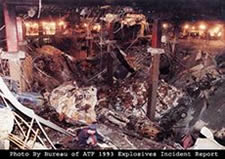- 01: Introduction
- 02: History
- 03: Propellants, Firearms, and Ammunition Development
- 04: Modern Firearms Manufacture
- 05: Small Arms Ammunition
- 06: Evidence Handling Procedures
- Introduction
- Objectives
- AFTE Knowledge and Ability Factors
- Types of Evidence
- Associative Evidence
- The Crime Scene
- Evidence Submission
- Laboratory Evidence Handling
- Case Tracking Within the Laboratory
- Firearm and Toolmark Examination Considerations
- Selected Bibliography
- 07: Equipment and Instrumentation
- 08: Examination of Firearms
- 09: Cartridge and Shotshell Examination
- 10: Characterization and Evaluation of Fired Projectiles
- 11: Bullet Comparison and Identification
- 12: Gunshot Residue and Distance Determination
- 13: Toolmark Identification
- 14: Communicating Results
- Resources


The Crime Scene
Home > Evidence Handling Procedures > The Crime Scene

The aftermath of the World Trade Center
bombing in February 1993
No two crime scenes are the same. The nature of the crime and agency protocols determine how the scene is processed.
Safety
The first priority on arrival at a crime scene is to protect life. There are many circumstances in which safety is an issue at a crime scene. Examples include booby traps, risk of fire or explosion from unsafe apparatus at clandestine drug laboratories, exposure to biological hazards (e.g., blood-stained clothing and discarded needles from drug users), and physical and environmental hazards, including weather.
| Example: |
| A good example of physical hazards is the scene that confronted investigators at the World Trade Center bombing in February 1993. The bomb destroyed several floors of the parking garage. The first investigators were working in a highly unsafe environment due to a major power outage and water that froze after the fire was extinguished. |




